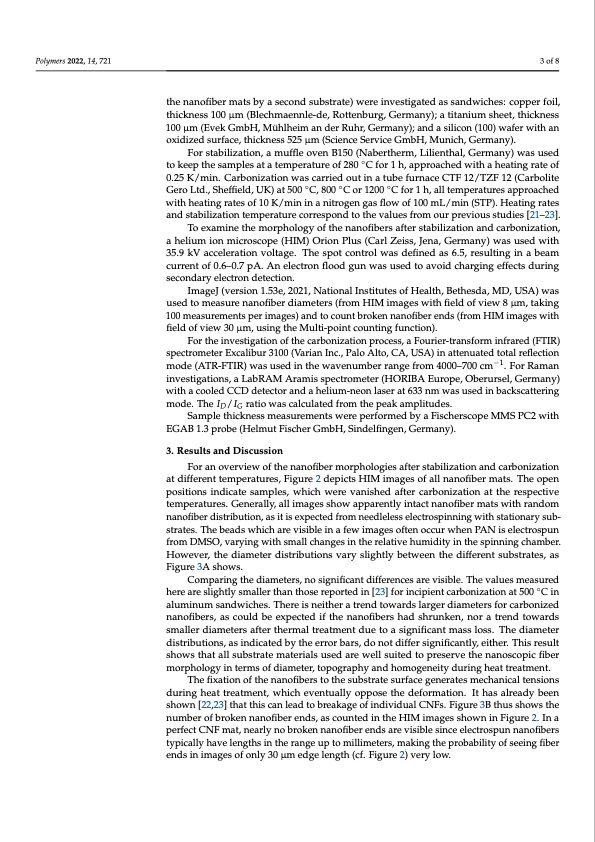
PDF Publication Title:
Text from PDF Page: 003
Polymers 2022, 14, 721 3 of 8 the nanofiber mats by a second substrate) were investigated as sandwiches: copper foil, thickness 100 μm (Blechmaennle-de, Rottenburg, Germany); a titanium sheet, thickness 100 μm (Evek GmbH, Mühlheim an der Ruhr, Germany); and a silicon (100) wafer with an oxidized surface, thickness 525 μm (Science Service GmbH, Munich, Germany). For stabilization, a muffle oven B150 (Nabertherm, Lilienthal, Germany) was used to keep the samples at a temperature of 280 ◦C for 1 h, approached with a heating rate of 0.25 K/min. Carbonization was carried out in a tube furnace CTF 12/TZF 12 (Carbolite Gero Ltd., Sheffield, UK) at 500 ◦C, 800 ◦C or 1200 ◦C for 1 h, all temperatures approached with heating rates of 10 K/min in a nitrogen gas flow of 100 mL/min (STP). Heating rates and stabilization temperature correspond to the values from our previous studies [21–23]. To examine the morphology of the nanofibers after stabilization and carbonization, a helium ion microscope (HIM) Orion Plus (Carl Zeiss, Jena, Germany) was used with 35.9 kV acceleration voltage. The spot control was defined as 6.5, resulting in a beam current of 0.6–0.7 pA. An electron flood gun was used to avoid charging effects during secondary electron detection. ImageJ (version 1.53e, 2021, National Institutes of Health, Bethesda, MD, USA) was used to measure nanofiber diameters (from HIM images with field of view 8 μm, taking 100 measurements per images) and to count broken nanofiber ends (from HIM images with field of view 30 μm, using the Multi-point counting function). For the investigation of the carbonization process, a Fourier-transform infrared (FTIR) spectrometer Excalibur 3100 (Varian Inc., Palo Alto, CA, USA) in attenuated total reflection mode (ATR-FTIR) was used in the wavenumber range from 4000–700 cm−1. For Raman investigations, a LabRAM Aramis spectrometer (HORIBA Europe, Oberursel, Germany) with a cooled CCD detector and a helium-neon laser at 633 nm was used in backscattering mode. The ID/IG ratio was calculated from the peak amplitudes. Sample thickness measurements were performed by a Fischerscope MMS PC2 with EGAB 1.3 probe (Helmut Fischer GmbH, Sindelfingen, Germany). 3. Results and Discussion For an overview of the nanofiber morphologies after stabilization and carbonization at different temperatures, Figure 2 depicts HIM images of all nanofiber mats. The open positions indicate samples, which were vanished after carbonization at the respective temperatures. Generally, all images show apparently intact nanofiber mats with random nanofiber distribution, as it is expected from needleless electrospinning with stationary sub- strates. The beads which are visible in a few images often occur when PAN is electrospun from DMSO, varying with small changes in the relative humidity in the spinning chamber. However, the diameter distributions vary slightly between the different substrates, as Figure 3A shows. Comparing the diameters, no significant differences are visible. The values measured here are slightly smaller than those reported in [23] for incipient carbonization at 500 ◦C in aluminum sandwiches. There is neither a trend towards larger diameters for carbonized nanofibers, as could be expected if the nanofibers had shrunken, nor a trend towards smaller diameters after thermal treatment due to a significant mass loss. The diameter distributions, as indicated by the error bars, do not differ significantly, either. This result shows that all substrate materials used are well suited to preserve the nanoscopic fiber morphology in terms of diameter, topography and homogeneity during heat treatment. The fixation of the nanofibers to the substrate surface generates mechanical tensions during heat treatment, which eventually oppose the deformation. It has already been shown [22,23] that this can lead to breakage of individual CNFs. Figure 3B thus shows the number of broken nanofiber ends, as counted in the HIM images shown in Figure 2. In a perfect CNF mat, nearly no broken nanofiber ends are visible since electrospun nanofibers typically have lengths in the range up to millimeters, making the probability of seeing fiber ends in images of only 30 μm edge length (cf. Figure 2) very low.PDF Image | Carbonization of Electrospun PAN Nanofibers

PDF Search Title:
Carbonization of Electrospun PAN NanofibersOriginal File Name Searched:
polymers-14-00721.pdfDIY PDF Search: Google It | Yahoo | Bing
Sulfur Deposition on Carbon Nanofibers using Supercritical CO2 Sulfur Deposition on Carbon Nanofibers using Supercritical CO2. Gamma sulfur also known as mother of pearl sulfur and nacreous sulfur... More Info
CO2 Organic Rankine Cycle Experimenter Platform The supercritical CO2 phase change system is both a heat pump and organic rankine cycle which can be used for those purposes and as a supercritical extractor for advanced subcritical and supercritical extraction technology. Uses include producing nanoparticles, precious metal CO2 extraction, lithium battery recycling, and other applications... More Info
| CONTACT TEL: 608-238-6001 Email: greg@infinityturbine.com | RSS | AMP |